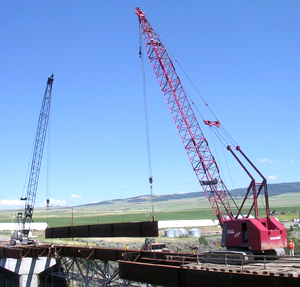
| CONNECTIONS |
IDAHO
ITD
HOME
511 TRAVEL SERVICES
IDAHO
DMV
ITD
NEWS
HIGHWAY
SAFETY
IDAHO STATE POLICE
STATE OF IDAHO
NIATT
NATIONAL
AASHTO
AAMVA
AAA of IDAHO
FEDERAL HIGHWAYS
FEDERAL AVIATION
IDAHO STATE POLICE
NHTSA
NTSB
TRB
U.S. DOT
TRANSPORTER
Archives
Milestones
Comments
Idaho
Transportation
Department
Office of Communications
P.O. Box 7129
Boise, ID 83707
208.334.8005
Fax: 208.334.8563

 Unique Canyon Creek bridge awarded national honor
Unique Canyon Creek bridge awarded national honor
Nearly a decade ago, District 6 engineers stood on one side of the pristine Canyon Creek canyon and looked at the other. Their dilemma was how to best replace an aging three-span deck truss, built in 1932, with a new 375-foot steel structure.
Options included:
- A pre-stressed concrete girder bridge with three spans of approximately 125 feet
- A concrete arch with a main span of about 275 feet,
- A three-span steel slant-leg bridge, and
- An unbalanced three-span steel girder bridge with spans of about 79 feet on both ends and a 217-foot center span.
They chose option four and set out to build a modern bridge over the environmentally sensitive canyon on Idaho 33. To protect the canyon’s natural qualities, no access was allowed below the rim and disturbance to the canyon was required to be minimal.
 The result is an award-winning bridge, designed in-house, that preserved the unique qualities of the canyon yet serves the needs of rural and agricultural traffic. Built by Sletten Construction Co. of Great Falls, Mont., the bridge recently received a 2007 Merit Award in the “medium span” category from the American Institute of Steel Construction based in Chicago.
The result is an award-winning bridge, designed in-house, that preserved the unique qualities of the canyon yet serves the needs of rural and agricultural traffic. Built by Sletten Construction Co. of Great Falls, Mont., the bridge recently received a 2007 Merit Award in the “medium span” category from the American Institute of Steel Construction based in Chicago.
The Canyon Creek Bridge was featured, along with other award winners, in a recent edition of Modern Steel Construction magazine.
“After the foundation investigation was completed, the arch and slant-leg options were ruled out because solid rock was over 70 feet below the skewback locations,” according to the project description.
‘In order to construct and erect the concrete girder option, temporary access roads would be required in the canyon, which would be both expensive and disruptive to the environment.”
In contrast, the final unbalanced design enabled construction of short spans on both sides of the canyon where cranes were stationed to work on the center span. That prevented intrusion into the canyon with temporary access roads.
“The advantage of using steel girders for the unbalanced span configuration was that these girders could easily span the relatively long center span of 217 feet and yet be light enough to be erected with cranes sitting on te end span.
 The plans specifically stated that no large equipment would be allowed below the rim of the canyon. However, the end segments, once they were in place, could be used as erection platforms for the cranes setting the center drop-in segments.”
The plans specifically stated that no large equipment would be allowed below the rim of the canyon. However, the end segments, once they were in place, could be used as erection platforms for the cranes setting the center drop-in segments.”
ITD bridge engineers indicate Canyon Creek Bridge is the first steel bridge built in Idaho with the girders being used as a platform to complete the erection. It also is the first bridge to incorporate micro-pile foundations at the end of the short spans, said Umesh Narsinghani of Headquarters bridge design. It is one of the more complex bridges designed in-house, he added. He credits the District 6 design and construction crews for accomplishing the Hurclean task.
Construction began late in the 2005 season and was completed in August 2006. The award, presented late last year, required the bridge to be open and carrying traffic.
Project summary: Of utmost importance in this project was the preservation of a pristine canyon. Since no access roads below the canyon rim were allowed, conventional construction techniques could not be used. The end result is a sleek weathering steel lbridge – a complement to the rugged environment. By the numbers |
Published 7-11-8